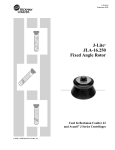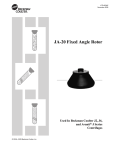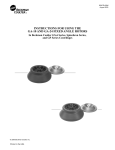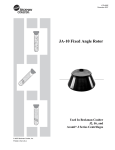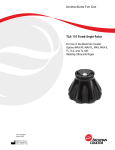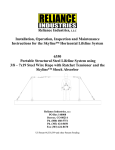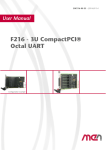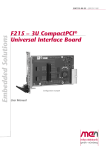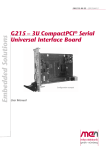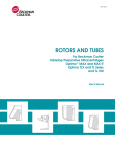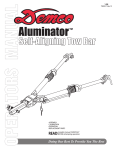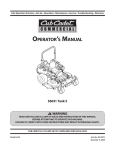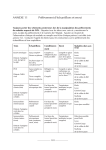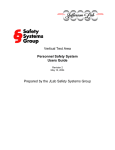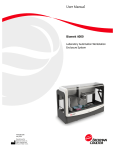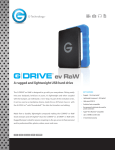Download JA-12 Fixed Angle Rotor Manual
Transcript
J-TB-051AG July 2009 JA-12 Fixed Angle Rotor Used In Beckman Coulter J2 and Avanti® J Series Centrifuges © 2009 Beckman Coulter, Inc. JA-12 Rotor ! SAFETY NOTICE This safety notice summarizes information basic to the safe use of the rotor described in this manual. The international symbol displayed above is a reminder to the user that all safety instructions should be read and understood before operation or maintenance of this equipment is attempted. When you see the symbol on other pages throughout this publication, pay special attention to the specific safety information presented. Observance of safety precautions will also help to avoid actions that could damage or adversely affect the performance of the rotor. This rotor was developed, manufactured, and tested for safety and reliability as part of a Beckman Coulter centrifuge/rotor system. Its safety or reliability cannot be assured if used in a centrifuge not of Beckman Coulter’s manufacture or in a Beckman Coulter centrifuge that has been modified without Beckman Coulter’s approval. ! ! ! 2 Handle body fluids with care because they can transmit disease. No known test offers complete assurance that such fluids are free of micro-organisms. Some of the most virulent—Hepatitis (B and C) viruses, HIV (I–V), atypical mycobacteria, and certain systemic fungi—further emphasize the need for aerosol protection. Handle other infectious samples according to good laboratory procedures and methods to prevent spread of disease. Because spills may generate aerosols, observe proper safety precautions for aerosol containment. Do not run toxic, pathogenic, or radioactive materials in this rotor without taking appropriate safety precautions. Biosafe containment should be used when Risk Group II materials (as identified in the World Health Organization Laboratory Biosafety Manual) are handled; materials of a higher group require more than one level of protection. The rotor and accessories are not designed for use with materials capable of developing flammable or explosive vapors. Do not centrifuge such materials in nor handle or store them near the centrifuge. Although rotor components and accessories made by other manufacturers may fit in the JA-12 rotor, their safety in this rotor cannot be ascertained by Beckman Coulter. Use of other manufacturers’ components or accessories in the JA-12 rotor may void the rotor warranty and should be prohibited by your laboratory safety officer. Only the components and accessories listed in this publication should be used in this rotor. ! Do not run an empty rotor. Place filled tubes in at least two opposing cavities. Make sure that filled containers are loaded symmetrically into the rotor and that opposing tubes are filled to the same level with liquid of the same density. ! If disassembly reveals evidence of leakage, you should assume that some fluid escaped the rotor. Apply all appropriate safety and decontamination procedures to the centrifuge and accessories. ! Never exceed the maximum rated speed of the rotor and labware in use. Refer to the section on RUN SPEEDS. ! Do not use sharp tools on the rotor that could cause scratches in the rotor surface. Corrosion begins in scratches and may open fissures in the rotor with continued use. JA-12 Rotor JA-12 FIXED ANGLE ROTOR 35° rmin rav rmax Axis of Rotation SPECIFICATIONS Maximum speed . . . . . . . . . . . . . . . . . . . . . . . . . . . . . . . . . . . . 12 000 rpm Critical speed range*. . . . . . . . . . . . . . . . . . . . . . . . . . . . . 400 to 1000 rpm Density rating at maximum speed. . . . . . . . . . . . . . . . . . . . . . . . . . 1.2 g/mL Maximum allowable imbalance of opposing loads. . . . . . . . . . . . . 2 grams Relative Centrifugal Field† at maximum speed at rmax (144 mm) . . . . . . . . . . . . . . . . . . . . . . . . . . . . . . . . . 23 200 × g at rav (108 mm) . . . . . . . . . . . . . . . . . . . . . . . . . . . . . . . . . . 17 400 × g at rmin (71 mm) . . . . . . . . . . . . . . . . . . . . . . . . . . . . . . . . . . 11 500 × g k factor at maximum speed . . . . . . . . . . . . . . . . . . . . . . . . . . . . . . . . . . 1244 Conditions requiring speed reduction . . . . . . . . . . . . . . . . .see RUN SPEEDS Number of tube cavities . . . . . . . . . . . . . . . . . . . . . . . . . . . . . . . . . . . . . 12 Available bottles and tubes . . . . . . . . . . . . . . . . . . . . . . . . . . . . . see Table 3 Nominal tube dimensions . . . . . . . . . . . . . . . . . . . . . . . . . . . . 30 × 115 mm Nominal tube capacity. . . . . . . . . . . . . . . . . . . . . . . . . . . . . . . . . . . . 50 mL Nominal rotor capacity . . . . . . . . . . . . . . . . . . . . . . . . . . . . . . . . . . 600 mL Approximate acceleration time to maximum speed (rotor fully loaded) . . . . . . . . . . . . . . . . . . . . . . . . . . . . . . . . . 3 1/2 min Approximate deceleration time from maximum speed (rotor fully loaded, max. brake) . . . . . . . . . . . . . . . . . . . . . . . . . . 4 min Rotor weight, maximum sample mass . . . . . . . . . . . . . . . . . . 11 kg (24 lb) Rotor material . . . . . . . . . . . . . . . . . . . . . . . . . . . . . . . . . . . . . . . . aluminum Rotor entry code for microprocessor-controlled instruments . . . . . . . . . 12 * The critical speed range is the range of speeds over which the rotor shifts so as to rotate about its center of mass. Passing through the critical speed range is characterized by some vibration. † Relative Centrifugal Field (RCF) is the ratio of the centrifugal acceleration at a specified radius and speed (rω 2) to the standard acceleration of gravity (g) according to the following formula: 2 --------RCF = rω g where r is the radius in millimeters, ω is the angular velocity in radians per second (2 π RPM /60), and g is the standard acceleration of gravity (9807 mm/s2). After substitution: RPM 2 RCF = 1.12 r ⎛ ------------⎞ ⎝ 1000 ⎠ 3 JA-12 Rotor DESCRIPTION This rotor has been manufactured in a registered ISO 9001 or 13485 facility for use with the specified Beckman Coulter centrifuges. Dual-locking Rotor Lid (364846) Small O-ring (961696) Large O-ring (961697) Rotor Body The JA-12 fixed angle rotor, rated for 12 000 rpm, is designed to hold up to twelve 50-mL tubes at a 35-degree angle (see Figure 1). Used in Beckman Coulter J2 and Avanti® J series centrifuges, the JA-12 rotor develops centrifugal forces that can efficiently pellet cells, bacteria, and food products; separate proteins, viruses, and subcellular fractions, and do phase separation and binding studies. The JA-12 rotor with dual-locking lid was tested1 to demonstrate containment of microbiological aerosols under normal operating conditions of the associated Beckman Coulter centrifuge, when used and maintained as instructed. The rotor is also available with a singlelocking lid. The JA-12 rotor has a patented fluid-containment annulus, located below the O-ring sealing surface (see Figure 2). The annulus helps to retain liquid that may escape from leaking or overfilled tubes, thereby minimizing the escape of liquid into the instrument chamber during centrifugation. Rotor Body Single-locking Lid O-ring Dual-locking Lid Figure 1. The JA-12 Fixed Angle Rotor 1 Validation of microbiological containment was done at an independent third-party testing facility (CAMR, Porton Down, UK, or USAMRIID, Ft. Detrick, MD, U.S.A.). Improper use or maintenance may affect seal integrity and thus containment. 4 JA-12 Rotor The rotor and lid are made of anodized aluminum. Two O-rings made of ethylene propylene rubber, one in the rotor lid and one in the rotor body, help to maintain atmospheric pressure inside the rotor during centrifugation when they are properly lubricated. Pins in the rotor drive hole mate with the centrifuge drive hub to prevent the rotor from slipping during acceleration and deceleration. See the Warranty at the back of this manual for warranty information. Annulus Figure 2. Fluid-Containment Annulus PREPARATION AND USE Specific information about the JA-12 rotor is given here. Use the Rotors and Tubes for Beckman Coulter J Series Centrifuges manual (publication JR-IM) and the centrifuge instruction manual along with this manual for complete rotor and accessory operation. ➠ NOTE Although rotor components and accessories made by other manufacturers may fit in the JA-12 rotor, their safety in this rotor cannot be ascertained by Beckman Coulter. Use of other manufacturers’ components or accessories in the JA-12 rotor may void the rotor warranty and should be prohibited by your laboratory safety officer. Only the components and accessories listed in this publication should be used in this rotor. 5 JA-12 Rotor PRERUN SAFETY CHECKS Read the Safety Notice page at the front of this manual before using the rotor. 1. Make sure that the rotor and lid are clean and show no signs of corrosion or cracking. 2. Refer to Appendix A in Rotors and Tubes for the chemical compatibilities of all materials used. 3. Verify that the tubes being used are listed in Table 3. ROTOR PREPARATION For runs at other than room temperature, refrigerate or warm the rotor beforehand for fast equilibration. 1. Be sure that metal threads in the rotor are clean and lightly but evenly lubricated with Spinkote™ lubricant (306812). Also ensure that O-rings are lightly but evenly coated with silicone vacuum grease (335148). 2. Load the filled containers symmetrically into the rotor. (Refer to TUBES on page 15 for information about containers.) If fewer than twelve tubes are being run, they must be arranged symmetrically in the rotor (see Figure 3). Opposing tubes must be filled to the same level with liquid of the same density. Figure 3. Typical Examples of Arranging Tubes in the Rotor 6 JA-12 Rotor OPERATION • Precool the rotor in the centrifuge or in a refrigerator before use— especially before short runs—to ensure that the rotor reaches the set temperature. A suggested precooling cycle is a minimum of 30 minutes at 2000 rpm at the required temperature. • If you are using a microprocessor-controlled centrifuge (Avanti J series and some J2 models), be sure to enter rotor code 12. Refer to your centrifuge instruction manual for additional information. ! CAUTION During acceleration in an Avanti J series centrifuge, the JA-12 rotor may be misidentified as a JA-14 rotor. If such misidentification occurs, it is possible to set the run speed to 14 000 rpm and operate the rotor at that speed. To prevent misidentification, always select the JA-12 rotor and a maximum speed of 12 000 rpm during run setup, and do not change these settings. Do not run the JA-12 rotor above 12 000 rpm at any time, or labware failure may result. INSTALLING THE ROTOR Rotor Drive Pin Orientation Two metal pins inside the rotor drive hole engage with teeth on the centrifuge drive hub to prevent the rotor from slipping during acceleration and deceleration (see Figure 4). When the rotor is properly installed, the pins sit either in the drive hub grooves or on top of the hub surface (Figure 5). In rotors manufactured since early 1997, the rotor pins are positioned parallel to the BECKMAN name engraved at the center of the rotor body (see Figure 6). Knowing the pin orientation before you install the rotor will help to ensure that you position the rotor properly on the hub, minimizing the chance of hub damage. Follow the steps below. 7 JA-12 Rotor BECKMAN Rotor Drive Hole Drive Pins Avanti J Centrifuge Drive Spindle Hub Figure 4. Rotor Drive Pin Location and Orientation Drive Hub Grooves (4) Rotor Pins (2) Teeth (2) Drive Hub Drive Hub Drive Spindle Assembly Drive Spindle Assembly Older Model Centrifuges — Be sure the pins in the rotor drive hole are seated in the grooves of the drive spindle hub as shown. Newer Model Centrifuges — Be sure the pins in the rotor drive hole are not sitting on top of the teeth on the drive spindle hub. Figure 5. Centrifuge Drive Hub Configurations 8 JA-12 Rotor Side View KM EC A N B Top View Figure 6. Installing the Rotor Rotor Lid Configurations The rotor has two available lid configurations. Tie-down Knob Daisy Knob • The dual-locking lid (364846) allows the lid to be attached to and removed from the rotor outside the centrifuge, so that tubes can be loaded and unloaded under a safety hood. The dual-locking lid consists of a daisy knob that attaches the lid to the rotor body, and a tie-down knob that attaches the rotor to the centrifuge drive hub. Lubricate Threads Tie-down Knob • The single-locking lid (360991) has a tie-down knob that secures the rotor to the centrifuge drive spindle. The rotor must be placed in the centrifuge before the lid is attached. Lubricate Threads 9 JA-12 Rotor Rotor Installation 1. To prevent the rotor from sticking to the centrifuge drive hub, apply a thin coat of Spinkote lubricant to the rotor drive pins and to the lid knob threads. 2. Lightly coat the large and small O-rings with silicone vacuum grease. 3. Dual-locking lid only. Place filled tubes into the rotor, then place the lid on the rotor and turn the daisy knob to the right (clockwise) until secure. Do not overtighten. 4. Turn the rotor until the BECKMAN name is either horizontal or perpendicular to the drive hub pins or teeth (see Figure 4). Or, rotate the drive spindle to align the hub pins or teeth with the rotor drive pins. 5. Carefully lower the rotor straight down onto the centrifuge drive spindle hub. Do not drop the rotor onto the spindle hub. 6. Slowly turn the rotor around the drive spindle to make sure that it is properly seated. In rare cases, the rotor pins can rest on top of the spindle hub pins or teeth, which prevents the rotor from being secured to the drive spindle. Turning the rotor after installing it will move the pins into proper position. 7. Secure the rotor to the centrifuge drive spindle as follows. Dual-locking lid: press the lid knob down and turn it to the right (clockwise) until secure, no more than two full turns. Do not overtighten. Single-locking lid: place filled tubes into the rotor, then place the lid on the rotor. Press the lid knob down and turn it to the right (clockwise) until secure. Do not overtighten. 10 JA-12 Rotor TEMPERATURE To ensure that the JA-12 rotor reaches the required temperature during the run, follow the appropriate instructions below for the centrifuge being used. Avanti J Series Centrifuges Enter the temperature according to the instructions in your centrifuge instruction manual. No additional input is required. J2 Series Centrifuges Enter the required temperature and the appropriate temperature compensation units (see Tables 1 and 2) on the centrifuge control panel as follows. Table 1. Temperature Compensation Settings for Analog- and Microprocessor-Controlled Centrifuges (Models J2-HS, JS-21, J2-MI, J2-21M, J2-MC, and J2-21M/E). Interpolate if intermediate values are required. Required Sample Temperature (°C) Rotor Speed (rpm) –20 –10 2 5 10 20 40 12 000 N –6 –6 –7 –7 –6 –9 10 000 –3 –4 –5 –5 –5 –5 –9 5 000 –1 –3 –3 –4 –4 –5 –9 An “N” indicates that the rotor cannot achieve the required temperature at this speed. 11 JA-12 Rotor Table 2. Temperature Compensation Settings for the Model J2-HC Analog Centrifuge. Interpolate if intermediate values are required. Required Sample Temperature (°C) Rotor Speed (rpm) –20 –10 2 5 10 20 40 12 000 N –3 –2 –2 –2 –2 –1 10 000 –2 –2 –1 –1 –1 –1 –1 5 000 –1 –1 0 0 0 0 0 An “N” indicates that the rotor cannot achieve the required temperature at this speed. Analog J2 Series Centrifuges (Models J2-HS and J2-HC) 1. Turn the SET knob on the centrifuge control panel to the required temperature. 2. Find the compensation value in Table 1 for Models J2-HS or Table 2 for Model J2-HC that corresponds to the required temperature and run speed. Set the COMP dial to that setting. (Interpolate if intermediate values are required.) ➠ NOTE Temperature settings for earlier model centrifuges must be empirically determined. Microprocessor-Controlled J2 Series Centrifuges (Models J2-MI and J2-MC) 1. Press the [TEMP] key on the centrifuge control panel and then use the keypad to enter the temperature. 2. Find the compensation value in Table 1 that corresponds with the set temperature and run speed. 3. Press [COMP ADJ]. The word “COMP” flashes below the TEMPERATURE display and the display flashes. 12 JA-12 Rotor 4. Use the keypad to enter the required compensation value. Press the [ ± . ] key to enter a minus sign; pressing it again will remove the minus sign. 5. Check the temperature display. (If the entry is incorrect, press [ce] and reenter the digits.) 6. When the entry is correct, press [ENTER/RECALL]. ➠ NOTE To clear a COMP ADJ entry, press [COMP ADJ], [0], and [ENTER/RECALL]. REMOVAL AND SAMPLE RECOVERY ! CAUTION If disassembly reveals evidence of leakage, you should assume that some fluid escaped the rotor. Apply all appropriate safety and decontamination procedures to the centrifuge and accessories. Dual-locking Lid 1. Place one hand on the rotor to keep it from turning. Grasp the round tie-down knob with your other hand and turn the knob to the left (counterclockwise) until the stem disengages from the drive hub threads. 2. Hold the knob or place your hands on the rotor and lift the rotor straight up off the drive hub. 3. Place the rotor on a counter or bench top under a safety hood. 4. Grasp the daisy knob and turn it to the left (counterclockwise) until it disengages. 5. Remove the lid and set it aside. 13 JA-12 Rotor Single-locking Lid 1. Unscrew the tie-down knob. 2. Remove the lid and set it aside. 3. Lift the rotor straight up off the drive hub. If the Rotor Sticks to the Centrifuge Drive Hub If the rotor sticks to the centrifuge drive hub, use the removal tool (360998) to release it as follows (see Figure 7). Rotor Removal Tool (360998) Figure 7. Using the Rotor Removal Tool ➠ 14 NOTE This procedure requires you to remove the rotor lid while the rotor is in the centrifuge. If you are using the dual-locking lid, the biosafe seal provided by this mechanism will be broken when the lid is removed. Consult your laboratory safety officer for the proper safety procedures to follow in this case. JA-12 Rotor 1. Remove the lid. 2. Screw the removal tool into the threaded opening. As the tool tightens down it will push against the drive hub, forcing the rotor up and off the hub. 3. Lift the rotor up and out of the centrifuge by the removal tool handle or by holding the rotor with your hands. 4. Unscrew the removal tool and remove it from the rotor. ➠ NOTE Never run the rotor with the removal tool in place. Lubricate the centrifuge drive hub with a light coat of Spinkote to prevent further sticking. TUBES The JA-12 rotor uses the tubes listed in Table 3. Be sure to use only those items listed, and to observe the maximum speed limits and fill volumes shown. (Maximum fill volume is the maximum amount that can be centrifuged in the container listed.) Refer to Appendix A in Rotors and Tubes for information on the chemical compatibilities of tube and accessory materials. ! CAUTION The tubes listed in Table 3 should be used one time only. Tube damage and sample leakage will result from repeated use. Do not use glass tubes in this rotor. 15 JA-12 Rotor Temperature Limits • Plastic containers have been centrifuge tested for use at temperatures between 2 and 25°C. For centrifugation at other temperatures, pretest containers under anticipated run conditions. • If plastic containers are frozen before use, make sure that they are thawed to at least 2°C prior to centrifugation. Table 3. Tubes for the JA-12 Fixed Angle Rotor Manufacturer Description Nominal Dimensions (mm) Nominal Volume (mL) Max. Fill Volume (mL) Manufacturers’ Maximum Recommended g-force for tube Corning Polypropylene, capped 30 × 115 50 45 9400 × g Falcon Polypropylene, capped 30 × 115 50 45 9400 × g Sarstedt Polypropylene, capped 29 × 115 50 40 8800 × g The JA-12 rotor generates g-forces higher than the tube manufacturers’ recommended maximums (see Table 3). Running these tubes above the recommended maximum g-forces will cause white striations known as crazing (see Figure 8). Moderate crazing will not affect run results or cause tube leakage. However, repeated tube usage and/or long run times will eventually lead to tube failure. To minimize the possibility of tube failure, observe the following conditions. • Do not use tubes more than once. • Discard crazed tubes. • Do not allow the run length at maximum speed to exceed 30 min. • Refer to Table 4 to find the g-forces produced at various speeds in the rotor, and limit run speed to the speed that produces the maximum recommended g-force for the tube in use. Beckman Coulter tests indicate that the Sarstedt tubes exhibit more crazing than the Corning or Falcon, and that due to slight dimensional differences, the Corning tubes exhibit less crazing than the Falcon. 16 JA-12 Rotor Figure 8. Examples of Tubes with Minimum and Moderate Crazing RUN TIMES The k factor of the rotor is a measure of the rotor’s pelleting efficiency. Beckman Coulter has calculated the k factors for all of its rotors, at maximum speed with full tubes, using the following formula: ln ( rmax ⁄ rmin ) 10 13 k = ------------------------------------- × -----------3600 ω2 (1) where ω is the angular velocity of the rotor in radians per second (ω = 0.105 × rpm), rmax is the maximum radius, and rmin is the minimum radius. After substitution: (2.533 × 10 11) ln ( rmax ⁄ rmin ) k = ------------------------------------------------------------------------rpm 2 (2) 17 JA-12 Rotor In the JA-12 rotor, the k factor is 1244 for full 50-mL tubes at maximum speed.2 For containers that nominally hold less than 50 mL, the k factors will be different. Calculate the k factors for these containers using equation (2). Use the k factor in the following equation to estimate the run time t (in hours) required to pellet particles of known sedimentation coefficient s (in Svedberg units, S). k t = -s (3) For example, at 12 000 rpm E. coli (s = 3600 S) will pellet in 1244 t = ------------ ≈ 30 min 3600 (4) Run times can be estimated for centrifugation at less than maximum speed by adjusting the k factor as follows: 2 12 000 k adj = k rated ⎛---------------------------------------- ⎞ ⎝ actual run speed ⎠ (5) Run times can also be estimated from data established in prior experiments using a different rotor if the k factor of the previous rotor is known. For any two rotors, a and b, ka ta ----= -----tb kb (6) where the k factors have been adjusted for the actual run speed used. For more information on k factors, see Use of k Factor for Estimating Run Times from Previously Established Run Conditions (publication DS-719). 2 Based 18 on sedimentation in water at 20°C. JA-12 Rotor RUN SPEEDS SPEED The centrifugal force at a given radius in a rotor is a function of run speed. Comparisons of forces between different rotors are made by comparing the rotors’ relative centrifugal fields (RCF). When rotational speed is selected so that identical samples are subjected to the same RCF in two different rotors, the samples are subjected to the same force (see Table 4). RPM/RCF Do not select rotational speeds higher than the maximums you have determined to be appropriate for your protocols (in no case above 12 000 rpm). When solutions more dense than 1.2 g/mL are centrifuged in this rotor, use equation (7) to calculate the reduced maximum allowable rotor speed. reduced maximum speed = (ρ ) 1.2 g/mL --------------------------------------------------------density of tube contents (7) where ρ = maximum speed CARE AND MAINTENANCE MAINTENANCE ➠ Dual-locking Rotor Lid (364846) Large O-ring (961697) Small O-ring (961696) Check for Corrosion Rotor Body NOTE Do not use sharp tools on the rotor that could cause scratches in the rotor surface. Corrosion begins in scratches and may open fissures in the rotor with continued use. • Periodically (at least monthly) inspect the rotor, especially inside cavities, for rough spots or pitting, white powder deposits (frequently aluminum oxide), or heavy discoloration. If any of these signs are evident, do not run the rotor. Contact your Beckman Coulter representative for information about the Field Rotor Inspection Program and the rotor repair center. • Before using the rotor, inspect the rotor drive pins to ensure that they are not damaged. Damaged drive pins can prevent the rotor from seating properly on the centrifuge drive hub (Avanti J series centrifuges only). To inspect the drive pins, turn the rotor upside down and look into the drive hole in the center of the rotor. If the drive pins appear damaged, contact Beckman Coulter Field Service. 19 JA-12 Rotor Table 4. Relative Centrifugal Fields for the JA-12 Rotor. Entries in this table are calculated from the formula RCF = 1.12 r (RPM/1000)2 and then rounded to three significant digits. Relative Centrifugal Field (× g) Rotor Speed (rpm) At rmax (144 mm) At rav (108 mm) At rmin (71 mm) 12 000 23 200 17 400 11 500 11 000 19 500 14 600 9 620 10 000 16 100 12 100 7 950 9 000 13 100 9 800 6 440 8 000 10 300 7 740 5 090 7 000 7 900 5 930 3 900 6 000 5 810 4 360 2 860 5 000 4 030 3 020 1 990 4 000 2 580 1 940 1 270 3 000 1 450 1 090 716 2 000 645 484 318 Relative Centrifugal Fields for the JA-12 Rotor 24 000 RCF (× g) 20 000 16 000 rmax rmin rav 12 000 8 000 4 000 0 0 2 000 4 000 6 000 Speed (rpm) 20 8 000 10 000 12 000 JA-12 Rotor • Regularly lubricate the metal threads in the rotor and on the tie-down bolt with a thin, even coat of Spinkote lubricant. Failure to keep these threads lubricated can result in damaged threads. • Regularly apply silicone vacuum grease to the O-rings. Replace O-rings about twice a year or whenever worn or damaged. Refer to Appendix A in Rotors and Tubes for chemical compatibilities of rotor and accessory materials. Your Beckman Coulter representative provides contact with the Field Rotor Inspection Program and the rotor repair center. CLEANING Wash the rotor and rotor components immediately if salts or other corrosive materials are used or if spillage has occurred. Do not allow corrosive materials to dry on the rotor. Rotor Cleaning Kit (339558) Under normal use, wash the rotor frequently (at least weekly) to prevent buildup of residues. 1. Remove the O-rings before washing. 2. Wash the rotor and lid in a mild detergent, such as Beckman Solution 555™, that won’t damage the rotor. The Rotor Cleaning Kit (339558) contains two special plastic-coated brushes and two quarts of Solution 555 for use with rotors and accessories. Dilute the detergent 10 to 1 with water. ➠ NOTE Do not wash rotor components in a dishwasher. Do not soak in detergent solution for long periods, such as overnight. 3. Thoroughly rinse the cleaned rotor and components with distilled water. Small O-ring Large O-ring 4. Air-dry the rotor and lid upside down. Do not use acetone to dry the rotor. 5. Apply a thin, even coat of silicone vacuum grease to both O-rings before replacing them. 21 JA-12 Rotor Clean metal threads every 6 months, or as necessary. Use a brush and concentrated Solution 555. Rinse and dry thoroughly, then lubricate lightly but evenly with Spinkote to coat all threads. Periodically remove the O-rings and wipe clean as necessary. Clean the O-ring grooves with a cotton-tipped swab. Reapply a light film of silicone vacuum grease. DECONTAMINATION If the rotor (and/or accessories) becomes contaminated with radioactive material, it should be decontaminated using a solution that will not damage the anodized surfaces. Beckman Coulter has tested a number of solutions and found two that do not harm anodized aluminum: RadCon Surface Spray or IsoClean Solution (for soaking),3 and Radiacwash.4 ➠ NOTE IsoClean can cause fading of colored anodized surfaces. Use it only when necessary and remove it promptly from surfaces. While Beckman Coulter has tested these methods and found that they do not damage components, no guarantee of decontamination is expressed or implied. Consult your laboratory safety officer regarding the proper decontamination methods to use. If the rotor or other components are contaminated with toxic or pathogenic materials, follow all appropriate safety and decontamination procedures as outlined by your laboratory safety officer. 3 In U.S., contact Nuclear Associates (New York); in Eastern Europe and Commonwealth States, contact Victoreen GmbH (Munich); in South Pacific, contact Gammasonics Pty. Ltd. (Australia); in Japan, contact Toyo Medic Co. Ltd. (Tokyo). 4 In U.S., contact Biodex Medical Systems (Shirley, New York); internationally, contact the U.S. office to find the dealer closest to you. 22 JA-12 Rotor STERILIZATION AND DISINFECTION • The rotor and all rotor components can be autoclaved at 121°C for up to an hour. Remove the lid from the rotor and place the rotor and lid in the autoclave upside down. • Ethanol (70%)5 or hydrogen peroxide (6%) may be used on all rotor components, including those made of plastic. Bleach (sodium hypochlorite) may be used, but may cause discoloration of anodized surfaces. Use the minimum immersion time for each solution, per laboratory standards. While Beckman Coulter has tested these methods and found that they do not damage the rotor or components, no guarantee of sterility or disinfection is expressed or implied. When sterilization or disinfection is a concern, consult your laboratory safety officer regarding proper methods to use. Refer to publication IN-192, included in each box of tubes or bottles, for tube and bottle sterilization and disinfection procedures. STORAGE When the rotor is not in use, store it in a dry environment (not in the instrument) with the lid removed to allow air circulation so moisture will not collect in the tube cavities. 5 Flammability hazard. Do not use in or near operating centrifuges. 23 JA-12 Rotor RETURNING A ROTOR RGA Before returning a rotor or accessory for any reason, prior permission (a Returned Goods Authorization form) must be obtained from Beckman Coulter, Inc. This RGA form, which may be obtained from your local Beckman Coulter sales office, should contain the following information: • rotor serial number, • history of use (approximate frequency of use), • reason for the return, • original purchase order number, billing number, and shipping number, if possible, • name and phone number of the person to be notified upon receipt of the rotor or accessory at the factory, and • name and phone number of the person to be notified about repair costs, etc. To protect our personnel, it is the customer’s responsibility to ensure that the parts are free from pathogens and/or radioactivity. Sterilization and decontamination must be done before returning the parts. Smaller items (such as tubes, bottles, etc.) should be enclosed in a sealed plastic bag. All parts must be accompanied by a note, plainly visible on the outside of the box or bag, stating that they are safe to handle and that they are not contaminated with pathogens or radioactivity. Failure to attach this notification will result in return or disposal of the items without review of the reported problem. Use the address label printed on the RGA form when mailing the rotor and/or accessories. Customers located outside the United States should contact their local Beckman Coulter office. 24 JA-12 Rotor SUPPLY LIST ➠ NOTE Publications referenced in this manual can be obtained by calling Beckman Coulter at 1-800742-2345 in the United States, or by contacting your local Beckman Coulter office. Contact Beckman Coulter Sales (1-800-742-2345 in the United States), or your local Beckman Coulter office, or see the High Performance, High Speed, High Capacity Rotors, Tubes & Accessories catalog (BR-8102, available at www.beckmancoulter.com) for detailed information on ordering parts and supplies. For your convenience, a partial list is given below. REPLACEMENT ROTOR PARTS JA-12 rotor assembly, biosafe (with dual-locking lid) . . . . . . . . . . . JA-12 rotor assembly (with single-locking lid). . . . . . . . . . . . . . . . . Dual-locking lid. . . . . . . . . . . . . . . . . . . . . . . . . . . . . . . . . . . . . . . . . Single-locking lid . . . . . . . . . . . . . . . . . . . . . . . . . . . . . . . . . . . . . . . Tie-down kit (for use with dual-locking lid) . . . . . . . . . . . . . . . . . . . Tie-down kit (for use with single-locking lid) . . . . . . . . . . . . . . . . . Lid O-ring (ethylene propylene rubber) . . . . . . . . . . . . . . . . . . . . . . Rotor body O-ring (ethylene propylene rubber) . . . . . . . . . . . . . . . . Rotor removal tool . . . . . . . . . . . . . . . . . . . . . . . . . . . . . . . . . . . . . . 360992 360993 364846 360991 364922 364919 961697 961696 360998 SUPPLIES Tubes . . . . . . . . . . . . . . . . . . . . . . . . . . . . . . . . . . . . . . . . . . . . . . see Table 3 Removal tool . . . . . . . . . . . . . . . . . . . . . . . . . . . . . . . . . . . . . . . . . . . 360998 Rotor Cleaning Kit . . . . . . . . . . . . . . . . . . . . . . . . . . . . . . . . . . . . . . 339558 Solution 555 (1 qt). . . . . . . . . . . . . . . . . . . . . . . . . . . . . . . . . . . . . . . 339555 Silicone vacuum grease (1 oz) . . . . . . . . . . . . . . . . . . . . . . . . . . . . . 335148 Spinkote lubricant (2 oz) . . . . . . . . . . . . . . . . . . . . . . . . . . . . . . . . . . 306812 25 J SERIES ROTOR WARRANTY Subject to the conditions specified below and the warranty clause of the Beckman Coulter, Inc., terms and conditions of sale in effect at the time of sale, Beckman Coulter, Inc. agrees to correct either by repair, or, at its election, by replacement, any defects of material or workmanship which develop within seven (7) years after delivery of a J series rotor to the original buyer by Beckman Coulter, Inc. or by an authorized representative, provided that investigation and factory inspection by Beckman Coulter, Inc. discloses that such defect developed under normal and proper use. Should a Beckman Coulter centrifuge be damaged due to a failure of a rotor covered by this warranty, Beckman Coulter will supply free of charge all centrifuge parts required for repair. REPLACEMENT Any product claimed to be defective must, if requested by Beckman Coulter, Inc., be returned to the factory, transportation charges prepaid, and will be returned to Buyer with the transportation charges collect unless the product is found to be defective, in which case Beckman Coulter, Inc. will pay all transportation charges. A defective rotor will be replaced by Beckman Coulter, Inc. at its then current list price less a credit based upon the age of the rotor (years since date of purchase). The Buyer shall not receive credit until the claimed defective rotor is returned to Beckman Coulter’s Indianapolis, Indiana facility or delivered to a Beckman Field Service representative. The replacement price (cost to Buyer) for the respective rotor shall be calculated as follows: years 7 Replacement price = Current rotor list price × ------------ CONDITIONS 1. Except as otherwise specifically provided herein, this warranty covers the rotor only and Beckman Coulter, Inc. shall not be liable for damage to accessories or ancillary supplies including but not limited to (i) tubes, (ii) tube caps, (iii) tube adapters, or (iv) tube contents. 2. This warranty is void if the rotor has been subjected to customer misuse such as operation or maintenance contrary to the instructions in the Beckman Coulter rotor or centrifuge manual. 3. This warranty is void if the rotor is operated with a rotor drive unit or in a centrifuge unmatched to the rotor characteristics, or is operated in a Beckman Coulter centrifuge that has been improperly disassembled, repaired, or modified. DISCLAIMER IT IS EXPRESSLY AGREED THAT THE ABOVE WARRANTY SHALL BE IN LIEU OF ALL WARRANTIES OF FITNESS AND OF THE WARRANTY OF MERCHANTABILITY AND THAT BECKMAN COULTER, INC. SHALL HAVE NO LIABILITY FOR SPECIAL OR CONSEQUENTIAL DAMAGES OF ANY KIND WHATSOEVER ARISING OUT OF THE MANUFACTURE, USE, SALE, HANDLING, REPAIR, MAINTENANCE, OR REPLACEMENT OF THE PRODUCT. Beckman Coulter, Inc. • 250 S. Kraemer Blvd. • Brea, California 92821 Sales and Service: 1-800-742-2345 • Internet: www.beckmancoulter.com ©2009 Beckman Coulter, Inc. All rights reserved




























